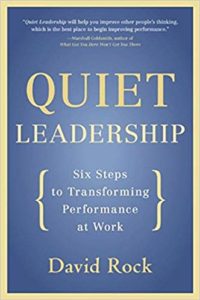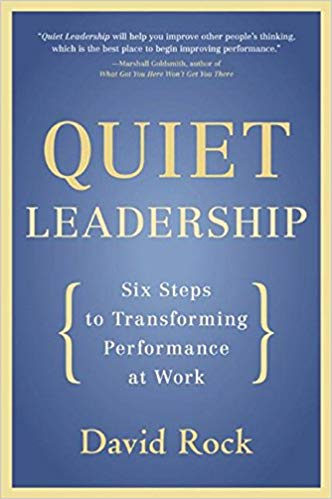 By: David Rock
By: David Rock
Reviewed by: Susan MacKenzie
The Premise: At the Roundtable, we work with some of the brightest leaders around. We coach to change their behaviour which results in better performance. If you are a people leader, how much of your energy gets focused on improving the performance of your team? In today’s work environment, we are constantly raising the bar on performance with the expectations that leaders have the ability to coach for results. What if there was a ‘magic bullet’ out there that helps people leaders really shift performance? Okay, not exactly a magic bullet but I have personally implemented some of the models and coaching questions from Quiet Leadership into my own group coaching with solid results.
David Rock is a leadership coach who brings in the neuroscience behind improving performance. His premise is that by working with how our brains work and structured questioning, people will fire up new ways of thinking that in turn change how they feel, drives their behaviour and gets results. Most of the organizations we work with very carefully recruit the best and brightest needed in today’s knowledge economy.
The book gives you a brief neuroscience lesson on how our brains work and what this means for behaviour change. It’s then organized into Six Steps which provide models, tips for coaches, many examples and applications. The steps include a focus on thinking, listening for potential, speaking with intent, moving towards insight, creating new thinking and follow-up to ensure goals are achieved.
The Bottom-line: As a pragmatic coach, I’m always looking for what works in the real world and I think that this approach hits the mark. Whether you are experienced in coaching or not, there are lists of really good questions that take you out of the details and truly coach the person towards new insights and momentum to achieve. At the end of the book are specific ways to use their methodology to help a person solve a problem or make a decision. Most importantly, how a coach/boss can use it to give effective feedback.
One good a-ha for me was the importance of being succinct and specific enough when coaching. Sometimes a coaching conversation can feel really ‘soft’ and this helps make sure your message is clear and targets the discussion. I’m also adding a lot of questions with numbers – your brain likes to quantify. “How often are you thinking about this?”, “On a scale of 1-10, how important is it to you to solve?” , “Where does this sit in your top 5 priorities?”.
If I had one caution, there are a lot of models in the book which would take practice to truly master (I took a 3-day course on this) so I would advise leaders to start implementing the parts that elevate your existing coaching level before feeling you had to do it all.
Recommendation: I recommend this book for coaches and for people leaders who need to coach for performance that effectively targets the issues and gets people thinking on their own. It’s an interesting and practical read.




